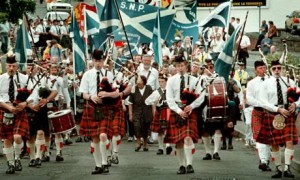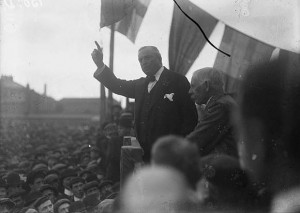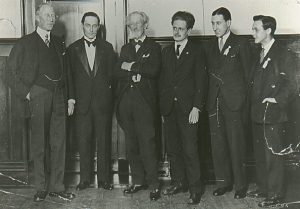“De Valera’s other Ireland?” The Irish Free State and Scottish nationalism, 1922-39

By Timothy Ellis.
Over the summer, as I was working in an archive, I found a rather interesting cartoon. It depicted a family in Highland dress alongside a single man in a top hat and exaggeratedly upper class clothing, sitting in a small boat tied to a larger ship. The man of the family demanded that his upper class companion ‘Cut the hawser and we’ll make a harbour on our own course.’ [1.]
The symbolism of this cartoon is clear. The small boat is Scotland, and the larger is England. The Scottish family represent Scottish nationalists, whilst the upper-class man represents Unionism. The rope or ‘hawser’ between the two boats is the Union. Yet, this cartoon was not published in a Scottish newspaper, but rather in the journal of a political party in the Irish Free State, the Fianna Fáil Bulletin.
This raises some interesting questions: what connections existed between the Irish Free State and Scottish nationalists? How did the Irish Free State offer a usable model for Scottish nationalists? Moreover, how did Free State politicians regard the growth of Scottish nationalism?
Dominion Status
The ‘inter-war period’ (1919-39) witnessed the growth of autonomy for the dominions of the British Empire: Canada, Australia, New Zealand, South Africa, Newfoundland and the Irish Free State. The sacrifices of British dominions during the First World War (such as the celebrated participation of ANZAC troops at Gallipoli) strengthened national identity within individual dominions, and thus stimulated calls for greater autonomy. A further factor which spurred on the movement for dominion autonomy was the creation of the Irish Free State in 1922.
As dominion status represented a reluctant compromise for Irish republican politicians in 1922, the Irish Free State proved to be the most ‘restless’ of the British dominions, and thus enthusiastically pushed for greater dominion autonomy, working with sympathetic Canadian, Australian and South African politicians. [2.]
Scottish nationalists were encouraged by the granting of Dominion status to Ireland in 1921.
The fruits of this came in the 1931 Statute of Westminster, the result of negotiations conducted at the 1926 and 1931 Imperial Conferences. This statute enunciated the policy of equality between the United Kingdom and all other dominions. These events were closely watched by Scottish politicians. The Scots Independent noted that ‘Ireland has made the way easier for us, for to Ireland we owe the Statute of Westminster, which has abolished the idea of an English-controlled Empire.’ [3.]
Ireland arguably offered a more ‘usable’ model for Scottish nationalists to emulate. The other dominions were relatively ‘new’ nations, having been established as settler colonies, and were situated many thousands of miles away from the United Kingdom. Ireland, like Scotland, was an ‘old’ nation which had been in union with England. Thus when the Free State became a dominion, it was far easier to see Scotland attaining the same status.
Home Rule for Scotland?

Moreover, for as long as Irish home rule had been debated, politicians had proposed extending home rule to Scotland. Isaac Butt, the ‘intellectual father’ of Irish home rule proposed the establishment of separate English, Scottish and Irish home rule jurisdictions.
In 1913, during the ‘Irish home rule crisis’, a bill extending home rule to Scotland reached its second reading, only to be delayed by the impending war. Nor was the Free State the only usable Irish example. The six counties of Northern Ireland had been granted a more limited form of home rule, within the UK in 1920, and this also offered more moderate Scottish nationalists a usable model.
Rather paradoxically, it was the Scottish Unionist party (the consequence of a merger between the Liberal Unionists and Conservatives in Scotland) that was most influenced by these developments. Scottish ‘Unionism’ represented more an emotive commitment to the ideals of the Empire and the Protestant faith, than a dry subscription to the Acts of 1707 and 1800.
The Scottish National Party was formed in 1934 from a merger of a split from Scottish unionists and more left leaning nationalists.
Within this imperial framework, dominion status was therefore highly desirable. In the words of John Buchan (a Unionist MP) that ‘every Scotsman should be a Scottish nationalist. If it could be proved that a Scottish parliament were desirable… Scotsmen should support it.’ [4.] In 1932 (the same year that de Valera’s Fianna Fáil first won an Irish election), the Scottish Party broke away from the Scottish Unionist Party. Two years later it would merge with the more left-leaning National Party of Scotland to form the SNP.
Both of the two main political parties in Ireland during the 1930s, Fine Gael (Cumann na nGaedheal before 1932) and Fianna Fáil watched events in Scotland with interest. For Cumann na nGaedheal/Fine Gael, the growing movement for dominion-derived autonomy or independence in Scotland underlined the continued desirability of the dominion model for Ireland.
As Commonwealth membership was a key plank in the party’s platform, Scottish nationalist aspirations for dominion status offered a useful rebuttal to those who doubted the desirability of the Free State’s place within the Empire.
In 1932, the Cumann na nGaedheal newspaper, United Irishman republished an article which had appeared in the Scots Independent. This article argued that Scotland should have independence ‘within the British Commonwealth of nations’ and ‘separate representation in the Imperial Conference and the League of Nations.’ [5.]

Not only did this piece thus highlight the benefits of membership of the Commonwealth, but also the League of Nations. It is worth noting that the Free State’s Cumman na nGaedheal government had managed to secure separate Irish membership of the League in 1924, by successfully registering the Anglo-Irish Treaty, despite British opposition.
On economic matters, the piece also supported ‘Scottish trade in the British Commonwealth and throughout the whole world,’ whilst ensuring that Scotland’s industry would ‘be fostered and protected equally with those of the south.’ [6.]
Here, there are parallels also with Cumann na nGaedheal economic policy. Whilst Cumann na nGaedheal had generally supported a policy of free trade, by 1931 it had started to introduce tariffs to protect the Irish market. [7.] That said, Cumann na nGaedheal was bitterly opposed to Fianna Fáil’s ‘Economic War’ with Britain, and broadly supported free trade within the Commonwealth.
The piece concluded by arguing that a Scottish nationalist government would ensure that ‘the great natural resources of our country… would be studied and developed. No longer would the greater part of the north of Scotland be a barren waste, a disgrace to civilisation.’ [8.] Whilst in office Cumann na nGaedheal had sponsored the development of a Hydroelectric dam at Ardnacrusha on the River Shannon- an achievement which was hailed both nationally and internationally. Though Scotland already had some small-scale schemes, it would not be until the Second World War that something matching the Shannon Scheme would be built.
Looking to Ireland
Whilst Cumann na nGaedheal looked on approvingly at the march of Scottish nationalism, many Scottish nationalists themselves looked to the leader of Fianna Fáil, Éamon de Valera. This was understandable, given the fact that de Valera was the President of Executive Council of the Irish Free State by the time the SNP had been founded, and Cumann na nGaedheal was now in opposition. As a politician who enthusiastically cultivated an international profile (de Valera served as President of the League of Nations assembly between 1938-9), he, in turn, was keen to engage with nationalists from other nations.

A deputation of Scottish nationalists visited both Northern Ireland and the Free State in 1934, and were able to meet de Valera. They reported back that they ‘were interested to learn from Mr. de Valera that… the grant of self-government to Scotland would help in settling matters between the Free State and the United Kingdom.’ [9.]
A year later, on the occasion of George V’s silver jubilee, both Scottish and Welsh nationalists sent a joint declaration to Éamon de Valera urging national self-determination for their respective nations. [10.] It is worth noting that these nationalists also visited Northern Ireland, which shows how Northern Ireland’s home rule was also viewed as a possible model for future autonomy.
Scotland itself had a very large Irish diaspora population. Most members of the Irish diaspora in Scotland were working class, and tended to lean leftwards in their politics. As a result, the Irish diaspora in Scotland were more likely to support de Valera’s economically interventionist Fianna Fáil party than the more middle class and fiscally conservative Cumann na nGaedheal/Fine Gael. Sources from the Fianna Fáil party archives reveal that there was at least one active Fianna Fáil branch in Glasgow in the 1930s. [11.]
A unifying thread across Irish and Scottish nationalism was cultural revival, sectarian antagonism divided them.
A unifying thread across Irish nationalism in this period was cultural revival. This, in particular, celebrated Ireland’s Celtic past and the Irish language. Following independence, successive Irish governments promoted cultural revival and the ‘Celtic’ past in various forms. The most obvious example is Aonach Tailteann, which was held in 1924, 1928 and 1932, and pitched itself as a revival of an ancient Irish festival, celebrating Irish sport and culture.
Its sporting events included Irish athletes from around the world, and it is worth noting that there were separate teams for the Irish in Scotland, Wales and England. The United Irishman praised the Scottish game of shinty which ‘grows year by year more familiar to Irish ears through international competitions between its native Scotland and Ireland.’ [12.]
Whilst there had been some matches in composite shinty-hurling as early as the 1890s, it was not until 1924 that shinty-hurling matches between Scotland and Ireland became a permanent fixture. Increasing acceptance of a Celtic identity no doubt strengthened a sense of popular identification between Scotland and Ireland. Mairead Carew notes that whilst ‘the term ‘Celtic… was a term of racist abuse for the Irish in the English and American media in the nineteenth and early twentieth century…[it] gained traction in a positive way from the 1930s onwards.’ [13.]
A complex relationship
One factor which perhaps complicated Irish-Scottish co-operation was sectarianism. The Irish state in the inter-war period confidently asserted a Catholic identity, as evidenced in the 1932 Eucharistic Congress in Dublin and de Valera’s 1937 Constitution which recognised the ‘special position’ of the Catholic church in Ireland.
Meanwhile, Protestantism remained an important component of Scottish identity. In 1923, a report was presented to the Church of Scotland entitled ‘The menace of the Irish race to our Scottish nationality.’ It is therefore important to remember that any discussion of links between Scottish and Irish nationalism must be foregrounded by a suitable degree of complexity.
During the ongoing decade of centenaries, there has been increasing discussion of the transnational dimensions of the Irish revolution. This is perhaps unsurprising, given that the events of the Revolution took place against the backdrop of the First World War and its aftermath.
Whilst research continues to illuminate the many complex links between Ireland and the international community in this period, we should not forget the transnational links between Ireland and the other nations of these islands, both during and after the Irish Revolution. It is certainly clear that the creation of the Irish Free State played a small, but significant role in the development of modern Scottish nationalism.
___________________
Notes:
[1.] Fianna Fáil Bulletin, March/April 1939 (Archives of University College, Dublin, Fianna Fáil party archives, P176/984).
[2.] See for instance, D. W. Harkness, The restless Dominion: the Irish Free State and the British Commonwealth of Nations, 1921-31 (London, 1969).
[3.] Scots Independent, March 1933. Quoted in the United Irishman, 11 March 1933.
[4.] The Scotsman, 31 January 2011 (https://www.scotsman.com/lifestyle/culture/books/why-are-we-paying-so-little-attention-on-the-70th-anniversary-of-john-buchan-s-death-1-1499150). Accessed 23 Aug. 2018.
[5.] United Irishman, 17 September 1932.
[6.] Ibid.
[7.] Mel Farrell, Party politics in a new democracy: the Irish Free State, 1922-37 (Basingstoke, 2017), p. 228.
[8.] United Irishman, 17 September 1932.
[9.] Belfast Newsletter, 18 August 1934.
[10.] Belfast Newsletter, 2 May 1935.
[11.] Archives of University College, Dublin, Fianna Fáil party archives, P176/537.
[12.] United Irishman, 3 June 1933.
[13.] Mairéad Carew, The quest for the Irish Celt: The Harvard archaeological mission to Ireland, 1932-1936 (Dublin, 2018), p. 188.
[14.] Syd Morgan, ‘Cwtsh-ing Ireland: Relations between the Welsh Nationalist Party & Fianna Fáil, 1932-1948’ (https://fournationshistory.wordpress.com/2015/04/20/cwtsh-ing-ireland-relations-between-the-welsh-nationalist-party-fianna-fail-1932-1948/). Accessed 23 Aug. 2018.